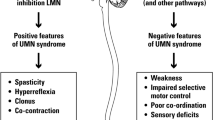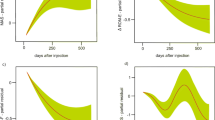Abstract
Background
With cerebral palsy (CP), an equinus deformity may lead to genu recurvatum. Botulinum toxin A (BtA) injection into the calf muscles is a well-accepted treatment for dynamic equinus deformity.
Questions/purposes
The purpose of this study was to determine whether BtA injections into the calf muscles to decrease equinus would decrease coexisting genu recurvatum in children with diplegic CP.
Methods
In a retrospective study, 13 children (mean age, 5 years) with spastic diplegic CP showing equinus and coexisting primary genu recurvatum, who were treated with BtA injections into the calf muscles, were included. Evaluations were done before and 6 and 18 weeks after intervention using three-dimensional gait analysis and clinical examinations according to a standardized protocol. Basic statistical analyses (power analysis, ANOVA) were performed to compare genu recurvatum before treatment and at 6 and 18 weeks after injection with BtA.
Results
During stance phase, maximum ankle dorsiflexion was increased substantially from −3.0° ± 14.3° before to 6.2° ± 14.2° 6 weeks after the injections. Despite this, with the numbers available, the amount of recurvatum in stance did not improve with treatment at either 6 or 18 weeks. There was significant improvement of knee hyperextension during stance phase of 6.2° between baseline and 18 weeks after BtA injection, but a genu recurvatum was still present in most patients.
Conclusions
Despite improvement of ankle dorsiflexion after injection with BtA, genu recurvatum did not show relevant improvement at 6 or 18 weeks after injection with the numbers available. Because knee hyperextension remained in most patients, other factors leading to genu recurvatum should be taken into consideration. In addition, a botulinum toxin-induced weakness of the gastrocnemius may explain why recurvatum gait was not significantly reduced.
Level of Evidence
Level IV, therapeutic study. See Guidelines for Authors for a complete description of levels of evidence.

Similar content being viewed by others
References
Aiona MD, Sussman MD. Treatment of spastic diplegia in patients with cerebral palsy: Part II. J Pediatr Orthop B. 2004;13:S13–38.
Baddar A, Granata K, Damiano DL, Carmines DV, Blanco JS, Abel MF. Ankle and knee coupling in patients with spastic diplegia: effects of gastrocnemius-soleus lengthening. J Bone Joint Surg Am. 2002;84:736–744.
Bang MS, Chung SG, Kim SB, Kim SJ. Change of dynamic gastrocnemius and soleus muscle length after block of spastic calf muscle in cerebral palsy. Am J Phys Med Rehabil. 2002;81:760–764.
Banks HH. The knee and cerebral palsy. Orthop Clin North Am. 1972;3:113–129.
Banks HH. The management of spastic deformities of the foot and ankle. Clin Orthop Relat Res. 1977;122:70–76.
Cosgrove AP, Corry IS, Graham HK. Botulinum toxin in the management of the lower limb in cerebral palsy. Dev Med Child Neurol. 1994;36:386–396.
Fry NR, Gough M, McNee AE, Shortland AP. Changes in the volume and length of the medial gastrocnemius after surgical recession in children with spastic diplegic cerebral palsy. J Pediatr Orthop. 2007;27:769–774.
Graham HK, Aoki KR, Autti-Ramo I, Boyd RN, Delgado MR, Gaebler-Spira DJ, Gormley ME, Guyer BM, Heinen F, Holton AF, Matthews D, Molenaers G, Motta F, Garcia Ruiz PJ, Wissel J. Recommendations for the use of botulinum toxin type A in the management of cerebral palsy. Gait Posture. 2000;11:67–79.
Hayek S, Gershon A, Wientroub S, Yizhar Z. The effect of injections of botulinum toxin type A combined with casting on the equinus gait of children with cerebral palsy. J Bone Joint Surg Br. 2010;92:1152–1159.
Houltram J, Noble I, Boyd RN, Corry I, Flett P, Graham HK. Botulinum toxin type A in the management of equinus in children with cerebral palsy: an evidence-based economic evaluation. Eur J Neurol. 2001;8(suppl 5):194–202.
Kadaba MP, Ramakrishnan HK, Wootten ME. Measurement of lower extremity kinematics during level walking. J Orthop Res. 1990;8:383–392.
Kim K, Shin HI, Kwon BS, Kim SJ, Jung IY, Bang MS. Neuronox versus BOTOX for spastic equinus gait in children with cerebral palsy: a randomized, double-blinded, controlled multicentre clinical trial. Dev Med Child Neurol. 2011;53:239–244.
Koog YH, Min BI. Effects of botulinum toxin A on calf muscles in children with cerebral palsy: a systematic review. Clin Rehabil. 2010;24:685–700.
Lee CL, Bleck EE. Surgical correction of equinus deformity in cerebral palsy. Dev Med Child Neurol. 1980;22:287–292.
Liu MQ, Anderson FC, Schwartz MH, Delp SL. Muscle contributions to support and progression over a range of walking speeds. J Biomech. 2008;41:3243–3252.
Maanum G, Jahnsen R, Stanghelle JK, Sandvik L, Keller A. Effects of botulinum toxin A in ambulant adults with spastic cerebral palsy: a randomized double-blind placebo controlled-trial. J Rehabil Med. 2011;43:338–347.
Metaxiotis D, Siebel A, Doederlein L. Repeated botulinum toxin A injections in the treatment of spastic equinus foot. Clin Orthop Relat Res. 2002;394:177–185.
Neptune RR, Kautz SA, Zajac FE. Contributions of the individual ankle plantar flexors to support, forward progression and swing initiation during walking. J Biomech. 2001;34:1387–1398.
Olney BW, Williams PF, Menelaus MB. Treatment of spastic equinus by aponeurosis lengthening. J Pediatr Orthop. 1988;8:422–425.
Perry J, Hoffer MM, Giovan P, Antonelli D, Greenberg R. Gait analysis of the triceps surae in cerebral palsy: a preoperative and postoperative clinical and electromyographic study. J Bone Joint Surg Am. 1974;56:511–520.
Polak F, Morton R, Ward C, Wallace WA, Doderlein L, Siebel A. Double-blind comparison study of two doses of botulinum toxin A injected into calf muscles in children with hemiplegic cerebral palsy. Dev Med Child Neurol. 2002;44:551–555.
Rodda JM, Graham HK, Carson L, Galea MP, Wolfe R. Sagittal gait patterns in spastic diplegia. J Bone Joint Surg Br. 2004;86:251–258.
Saraph V, Zwick EB, Uitz C, Linhart W, Steinwender G. The Baumann procedure for fixed contracture of the gastrosoleus in cerebral palsy: evaluation of function of the ankle after multilevel surgery. J Bone Joint Surg Br. 2000;82:535–540.
Simon SR, Deutsch SD, Nuzzo RM, Mansour MJ, Jackson JL, Koskinen M, Rosenthal RK. Genu recurvatum in spastic cerebral palsy: report on findings by gait analysis. J Bone Joint Surg Am. 1978;60:882–894.
Steele KM, Seth A, Hicks JL, Schwartz MS, Delp SL. Muscle contributions to support and progression during single-limb stance in crouch gait. J Biomech. 2010;43:2099–2105.
Sutherland DH, Cooper L, Daniel D. The role of the ankle plantar flexors in normal walking. J Bone Joint Surg Am. 1980;62:354–363.
Sutherland DH, Davids JR. Common gait abnormalities of the knee in cerebral palsy. Clin Orthop Relat Res. 1993;288:139–147.
Sutherland DH, Kaufman KR, Wyatt MP, Chambers HG. Injection of botulinum A toxin into the gastrocnemius muscle of patients with cerebral palsy: a 3-dimensional motion analysis study. Gait Posture. 1996;4:269–279.
Sutherland DH, Kaufman KR, Wyatt MP, Chambers HG, Mubarak SJ. Double-blind study of botulinum A toxin injections into the gastrocnemius muscle in patients with cerebral palsy. Gait Posture. 1999;10:1–9.
Svehlik M, Zwick EB, Steinwender G, Saraph V, Linhart WE. Genu recurvatum in cerebral palsy–part A: influence of dynamic and fixed equinus deformity on the timing of knee recurvatum in children with cerebral palsy. J Pediatr Orthop B. 2010;19:366–372.
Takahashi S, Shrestha A. The vulpius procedure for correction of equinus deformity in patients with hemiplegia. J Bone Joint Surg Br. 2002;84:978–980.
Wren TA, Rethlefsen S, Kay RM. Prevalence of specific gait abnormalities in children with cerebral palsy: influence of cerebral palsy subtype, age, and previous surgery. J Pediatr Orthop. 2005;25:79–83.
Yngve DA, Chambers C. Vulpius and Z-lengthening. J Pediatr Orthop. 1996;16:759–764.
Zwick EB, Svehlik M, Steinwender G, Saraph V, Linhart WE. Genu recurvatum in cerebral palsy–part B: hamstrings are abnormally long in children with cerebral palsy showing knee recurvatum. J Pediatr Orthop B. 2010;19:373–378.
Acknowledgments
We thank Simone Gantz for completing the statistics in this study, and the staff of Heidelberg’s motion laboratory for assistance in collecting the data.
Author information
Authors and Affiliations
Corresponding author
Additional information
Each author certifies that he or she, or a member of his or her immediate family, has no funding or commercial associations (eg, consultancies, stock ownership, equity interest, patent/licensing arrangements, etc) that might pose a conflict of interest in connection with the submitted article.
All ICMJE Conflict of Interest Forms for authors and Clinical Orthopaedics and Related Research editors and board members are on file with the publication and can be viewed on request.
Clinical Orthopaedics and Related Research neither advocates nor endorses the use of any treatment, drug, or device. Readers are encouraged to always seek additional information, including FDA-approval status, of any drug or device prior to clinical use.
Each author certifies that his or her institution approved the human protocol for this investigation, that all investigations were conducted in conformity with ethical principles of research, and that informed consent for participation in the study was obtained.
About this article
Cite this article
Klotz, M.C.M., Wolf, S.I., Heitzmann, D. et al. The Influence of Botulinum Toxin A Injections into the Calf Muscles on Genu Recurvatum in Children With Cerebral Palsy. Clin Orthop Relat Res 471, 2327–2332 (2013). https://doi.org/10.1007/s11999-013-2897-7
Received:
Accepted:
Published:
Issue Date:
DOI: https://doi.org/10.1007/s11999-013-2897-7




